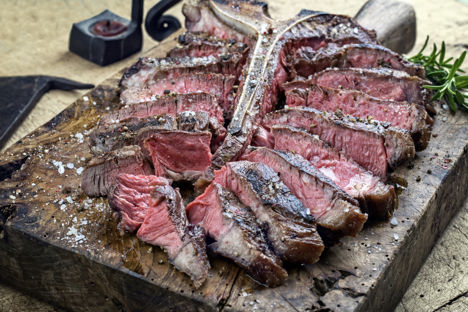
Bistecca alla Fiorentina: Tuscany's favourite steak
Beef is big business in Tuscany, and nowhere more so than Florence, where Fiorentini have been eating giant T-bone steaks – called bistecca alla Fiorentina – for hundreds of years. We go in search of the story behind this carnivorous delight.
Bistecca alla Fiorentina: Tuscany's favourite steak
Beef is big business in Tuscany, and nowhere more so than Florence, where Fiorentini have been eating giant T-bone steaks – called bistecca alla Fiorentina – for hundreds of years. We go in search of the story behind this carnivorous delight.
Head into the south of Tuscany – past the urban centres of Florence, Prato, Livorno and Pisa – and you’ll find the region’s agricultural heartland. The picturesque city of Siena lies down here too, with beautiful piazzas, a grand cathedral and UNESCO-protected town centre. Southeast of the city, the Val di Chiana (otherwise known as Valdichiana or the Chiana Valley) plunges down towards the Umbrian border, bisecting the fertile plains of Arezzo and Orvieto. Why are we here, you might ask? Well, the Chiana Valley is the birthplace of one of Tuscany’s greatest dishes, a gargantuan slab of T-bone steak known as bistecca alla Fiorentina.
Bistecca alla Fiorentina is, on the surface, a remarkably simple dish – it’s a huge thick-cut T-bone steak, cooked over blazing coals and shared between friends and family. There’s more to this dish than meets the eye though; in fact, the rules of bistecca alla Fiorentina are quite specific. The Val di Chiana has been home to native Italian Chianina cattle for at least 2,000 years, as recorded by Roman agricultural historian Columella around 55AD. That makes the Chianina one of the oldest documented cattle breeds in the world – they have ploughed fields and pulled carts here for centuries, but more recently, locals have discovered the delicious flavour of Chianina beef. Not only are Chianina cattle extremely large – bulls can grow up to 1.8 metres tall, weighing a whopping 1,600 kilograms – they’re also extremely lean. With machines ploughing the fields of Arezzo and Orvieto nowadays, Chianina can be bred exclusively for beef, and the result is incredible – lean, tender meat with a deep, rich flavour.
Bistecca can be made with beef from a range of cattle breeds, but the true bistecca alla Fiorentina should only ever come from the Chianina. Aside from the much-improved flavour of the Chianina, the size is also important – a bistecca alla Fiorentina is normally between three and four fingers thick, and as a result, the middle will always be rare. The lean meat of Chianina cattle is therefore perfect, coming out more tender and with more flavour than other breeds.
Another good reason for maintaining the tradition of eating Chianina beef bistecca is just that – tradition. Italy is not a country that takes tradition lightly – hundreds of cheeses, salumi, breads, pastas, wines, oils and vinegars are made using exactly the same methods and traditions today as they were hundreds of years ago. There’s a deep respect and reverence for the origin of good food in Italy, and though the origins of bistecca alla Fiorentina aren’t clear, there’s no doubt that the very first bistecca would have been made using Chianina beef.
The Feast of San Lorenzo takes place in Florence every year on 10 August, and as part of the celebration bonfires are lit all over the city and large amounts of meat are cooked. So the story goes, a large contingent of English knights referred to the barbecued beef as ‘beef steak’ – the amused locals mimicked them and the ‘beef steak’ became ‘bistecca’. If we know one thing from history, where there’s beef, there are almost certainly English people, so the story holds a modicum of sense in that respect.
So, beef from Chianina cattle, dry-aged for two-three weeks, but what about the cooking? It’s widely agreed that bistecca alla Fiorentina should be cooked over white-hot coals – just as it would have been at the Feast of San Lorenzo hundreds of years ago – and that the meat should only be cooked for three or four minutes on each side, before being given the very lightest touch of salt before eating. Some cooks use bunches of rosemary and sage to brush the steak with its juices as it cooks, but the addition of too much salt, aromatics or oil is regarded as a sign that the beef isn’t up to scratch. The relatively quick sear on either side results in a very rare steak, so If you don’t like rare beef, this might not be the dish for you – the sheer size of the steak means that, if you were to cook it to medium on the inside, the outside would be charcoal.
The bistecca alla Fiorentina comes from the same cut as the T-bone – a steak from the short loin that has a piece of fillet on one side and a piece of sirloin on the other (known as bistecca nel filetto and bistecca nella costola respectively). It’s worth being aware that if you order bistecca alla Fiorentina outside of Tuscany, you might only get the bistecca nel filetto! Many good trattorias will show you the piece of steak you’ve ordered before they cook it to avoid these sorts of mishaps. The additional joy of the bistecca alla Fiorentina is in the two very different steaks that you receive – the fillet melts in the mouth like butter, whilst the sirloin has a more tactile, chewy pleasure, as well as a richer flavour.
In case we hadn’t got this point across already, these steaks are huge – normally over a kilogram in weight. Florence is a city of meat-lovers after all, and trattorias here don’t skimp on the portions. You’d be well advised to round up a couple of meat-loving friends if you’re going to tackle one of these meaty mammoths, but don’t be dissuaded – working your way through this Florentine speciality is one of the greatest carnivorous pleasures you can have.

